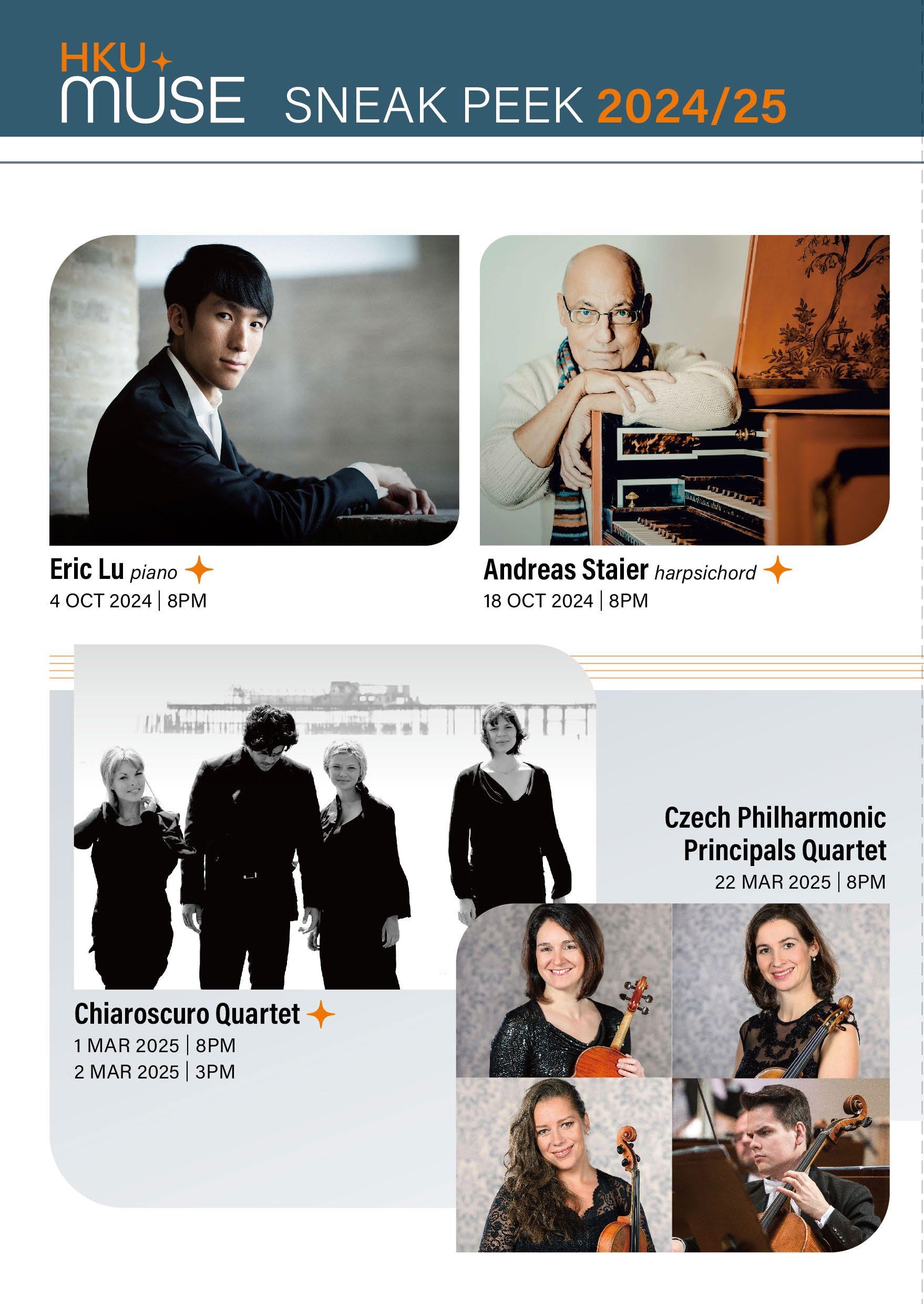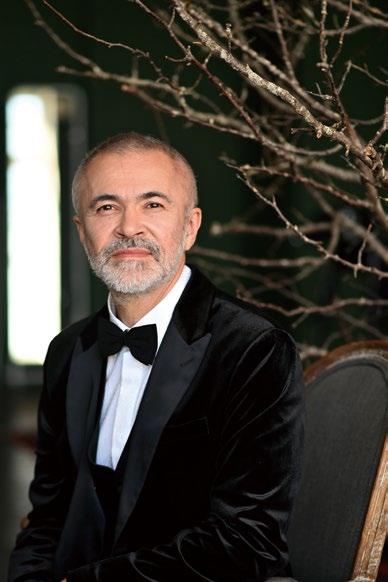
Welcome to the Grand Hall
Presented by
Thank you for coming to this HKU MUSE event. To ensure that everyone enjoys the music, please switch off your mobile phones and any other sound and light emitting devices before the performance. Unauthorised photography and audio/video recordings in the Hall are prohibited. Enjoy the concert and come again. Supported
by
us
Follow
5 MAY 2024 | SUN | 3PM
Grand Hall, The University of Hong Kong
Noah Bendix-Balgley, violin
Christoph Traxler, piano
MOZART Sonata for Violin and Piano No. 18 in G major, K. 301
Allegro con spirito
Allegro
KORNGOLD Much Ado About Nothing Suite, Op. 11
The Maiden in the Bridal Chamber
Dogberry and Verges (March of the Watch)
Scene in the Garden
Masquerade (Hornpipe)
RAVEL
Sonata for Violin and Piano No. 2 in G major
Allegretto
Blues. Moderato
Perpetuum mobile. Allegro
- INTERMISSION -
FRANCK Sonata for Violin and Piano in A major
Allegretto ben moderato
Allegro
Recitativo-Fantasia. Ben moderato – Molto lento
Allegretto poco mosso
GERSHWIN Selections from Porgy and Bess (arr. HEIFETZ) Summertime
A Woman Is a Sometime Thing
Bess, You Is My Woman Now
It Ain't Necessarily So
N oah Bendix-Balgley violin
Noah Bendix-Balgley enjoys a wide-ranging musical life as a violinist. He is First Concertmaster of the Berliner Philharmoniker and tours both as a chamber musician and as a soloist. His clear and heartfelt personal sound has reached and moved listeners around the world.
As soloist, Noah appears frequently with leading international orchestras, as well as in recital at the world's finest concert halls. Recent highlights include his concerto debut at Carnegie Hall as the featured soloist on the Berliner Philharmoniker USA tour under the direction of Kirill Petrenko, as well as concerto appearances with the Philharmonic Orchestras of Berlin, Dresden, Auckland, Nagoya, and Oklahoma City. He has also performed with the Verbier Festival Chamber Orchestra and the Shanghai, Utah, Quebec, Adelaide, and Pittsburgh Symphony Orchestras. He has toured with Apollo's Fire Orchestra performing on period instruments, performed the Brahms Double Concerto with Alisa Weilerstein and the Aspen Music Festival Orchestra, toured with the Stuttgart Chamber Orchestra, and given recitals at the Philharmonie Berlin, Beethoven-Haus Bonn, the National Forum of Music in Wrocław, and the National Concert Hall in Taipei. In the upcoming season, he curates and presents a week-long celebration of the violin with his hometown Asheville Symphony, including a solo violin recital and an all-concerto programme. He also returns to the Guangzhou Symphony Orchestra and makes his debuts with the NHK Symphony Orchestra and the Armenian State Symphony Orchestra.
Noah is a renowned performer of traditional klezmer music, a musical style that has been part of his life since an early age. He has performed groups such as Brave Old World, and has taught at many klezmer workshops. In 2016, Noah composed and premiered his own klezmer violin concerto, Fidl-Fantazye, with the Pittsburgh Symphony Orchestra, where he was concertmaster from 2011 to 2015. Since the premiere, he has also performed the work with the Baltimore Symphony, the China Philharmonic, and the Buffalo Philharmonic. In November 2021, he premiered the chamber orchestra version of Fidl-Fantazye with the Kammerakademie Potsdam, a version he also presented with members of the Berliner Philharmoniker in a special 'Late Night' klezmer concert at the Philharmonie Berlin.
A passionate chamber musician, Noah performs in several ensembles: in a trio with pianist Robert Levin and cellist Peter Wiley, with the Rosamunde String
2
BIOGRAPHIES
Quartet that includes members of the Los Angeles and New York Philharmonics, and with the multi-genre septet Philharmonix, which features members of both the Berlin and Vienna Philharmonic Orchestras. Philharmonix tours worldwide, has an ongoing multi-year residency at Vienna's Konzerthaus, and in 2022 released its third album on Deutsche Grammophon. In the 2023/24 season, he tours with Philharmonix around China, Korea, and Japan. Noah's other recent chamber highlights include performances at the Seattle Music Festival, Bergen International Festival, Sarasota Music Festival, ChamberFest Cleveland, Zermatt Music Festival, Aix-en-Provence, and La Jolla Summerfest.

Born in Asheville, North Carolina, Noah began playing the violin at age 4. At age 9, he played for Lord Yehudi Menuhin. He graduated from the Indiana University Jacobs School of Music and the Munich Hochschule. His principal mentors were Mauricio Fuks, Christoph Poppen, and Ana Chumachenco. A laureate of the 2009 Queen Elisabeth Competition, he also won top prizes at the Long-Thibaud Competition in France and the Postacchini Competition in Italy.
Now a gifted educator himself, Noah teaches at the Karajan Academy of the Berliner Philharmoniker. He has served on the juries of the Menuhin Competition, the Indianapolis International Violin Competition, and as chair of the violin jury at the Carl Nielsen Competition. He has given masterclasses at his alma mater Indiana University, and at academies around the world including Morningside Music Bridge, Domaine Forget, the Australian National Academy of Music, the Shanghai Orchestra Academy, and the Peabody Institute.
3
C hristoph Traxler piano
Austrian pianist Christoph Traxler enjoys a multifaceted career as soloist, chamber musician, and educator, and has toured and performed in the most prestigious concert halls worldwide. He has been hailed for his stylistic versatility and passionate performances.
Recent solo appearances include Beethoven piano concertos in the Toyota City Hall (Japan), collaborations with Manfred Honeck, Stefan Vladar, Michael Barenboim, Thomas Hampson, and performances at the Verbier Festival, Gstaad Menuhin Festival, and the Rheingau Festival.
He is a member of 'Philharmonix', a unique ensemble founded by members of the Vienna and Berlin Philharmonics that transcends stylistic boundaries and has been awarded the Opus Klassik prize in 2018.

An avid recording artist, Christoph Traxler can be heard on numerous albums with Deutsche Grammophon and Sony Classical, most recently on The Clarinet Trio Anthology , a comprehensive 7-CD collection covering the repertoire for clarinet, cello, and piano with his close chamber music partners Daniel Ottensamer and Stephan Koncz, which won the Prize of the Deutsche Schallplattenkritik . He has been regularly invited to perform with the Vienna Philharmonic as orchestral pianist. In 2022, Christoph Traxler was appointed Professor for Piano at the prestigious University of Music and Performing Arts in Vienna.
4

SUPPORT NOW
You can help us bring more impact, more joy, and more inspiration to the students and the community! Donate Online

HKU MUSE strives to inspire a life-long passion for the arts. We work hard to raise funds so that we can continue to curate innovative programmes and learning events on campus and beyond. Music lovers like you are our greatest supporters—please don't hesitate to share your generosity!
*Donations of HK$100 or above are tax-deductible.
WOLFGANG AMADEUS MOZART (1756-1791)
Sonata for Violin and Piano No. 18 in G major, K. 301
The G-major Sonata was originally conceived to be a work for the flute, yet later turning out to be the first piece of a set of six sonatas for the violin and piano (K. 301-306). Written in 1778, the set likely served to showcase Mozart's exquisite skills in both composition and performance during his sojourns in Mannheim and Paris, reminding us that Mozart was not only a gifted pianist, but also a talented violinist. In late 1777, Mozart wrote to his father about the reception of a concert of his held the day before, where he played his Cassation in B-flat major, K. 287: "As a finale I played my last Cassation in B-flat. They all opened their eyes! I played as though I were the finest fiddler in all Europe." Knowing by heart that his son was not boasting, Leopold Mozart (1719-1787) replied with affirmative encouragement: "I am not surprised that when you played your last Cassation they all opened their eyes. You yourself do not know how well you play the violin, if you will only do yourself credit and play with energy, with your whole heart and mind, yes, just as if you were the first violinist in Europe."
In two movements, the Sonata is adorned with the expressivity of the Mannheim style, as can be heard in its frequent excursions to the minor mode and eloquent use of dissonances. The piano is not a mere accompaniment of the violin solo but sings beautiful duets with it. In concertante style, the two instruments call and respond to each other while intermittently singing the same tune together in octaves. Sharing each other's themes and accompaniments, the piano and violin are engaged in a cordial conversation filled with elegance and joy.
ERICH WOLFGANG KORNGOLD (1897-1957)
Much Ado About Nothing Suite, Op. 11
Much Ado About Nothing is probably one of Shakespeare's most popular plays. With a long and rich history of productions and adaptations, the comedy has not only given rise to many award-winning actors and actresses, but also inspired a profusion of compositions in the forms of opera, film score, and incidental music. An example is the incidental score written in 19181919 by Korngold, a child prodigy who later became a renowned Hollywood composer. The music was commissioned by the local theatre company Wiener Volksbühne for a stage production directed by Max Reinhardt (1873-1943), to
6
PROGRAMME NOTES
be performed at the Schlosstheater in Schönbrunn Palace. But as Korngold was refining the orchestration, Wiener Volksbühne went bankrupt, meaning that the whole production had to be cancelled. Fortunately, the production and Korngold's music were rescued by the Burgtheater, which offered to finance the stage performances at the Schlosstheater. Well before the play was performed on stage, the Vienna audience might have already heard four segments of its music in the form of this suite, which Korngold adapted from the score under the advice of his father, Julius Leopold Korngold (1860-1945), who, as a music critic, saw the potential of his son's score also as concert music.
Shakespeare's comedy unfolds around two young noble couples, Claudio and Hero, and Benedick and Beatrice, both tricked by deception and eavesdropping to either break up or fall in love with each other. While Hero is set up to appear that she has cheated on Claudio, Benedick and Beatrice are made to overhear conversations on each other's love for themselves. In Shakespeare's time, 'nothing' is a homonym of 'noting'. The pun in the title thus associates the act of noticing embodied in gossiping and eavesdropping with triviality. Korngold's suite for violin and piano presents the musical materials of four scenes from the play in reverse order. The Maiden in the Bridal Chamber takes place before Hero's wedding with Claudio in Act IV Prelude, where Margaret and Hero light-heartedly tease Beatrice on her romance with Benedick. Dogberry and Verges from Act III Scene 2 presents a grotesque funeral march to portray the comic incompetence of the watchmen and their leader Dogberry, who finds no problem with his subordinates sleeping during the night watch and advises them against catching thieves. In Scene in the Garden from Act III Prelude, Beatrice is tricked to overhear a staged conversation between Hero and Ursula on Benedick's affection for her. Finally, Masquerade sonically represents the exuberant hornpipe dance in Act II Prelude, where Prince Don Pedro woos Hero on behalf of Claudio.
MAURICE RAVEL (1875-1937)
Sonata for Violin and Piano No. 2 in G major
CÉSAR FRANCK (1822-1890)
Sonata for Violin and Piano in A major
While Mozart's Sonata for Violin and Piano in G major is characterised by the 18th-century Mannheim concertante style, Franck's A-major Sonata, composed
7
in 1886 as a wedding gift for the Belgian violinist and composer Eugène Ysaÿe (1858-1931), exhibits the French style in the second half of the 19 th century, which also finds its expression in Ravel's G-major Sonata (1923-1927). In contrast to Mozart's Sonata, in which the piano and violin often answer to each other's melodies in a back-and-forth conversation, Ravel's and Franck's works endow the two instruments with more distinct roles and organise the thematic materials in more diverse ways. There are more extensive passages where the violin plays a lyrical line over sonorous piano chords or rolling-wave figurations. The thematic materials are not just presented horizontally but set in counterpoint to themselves or to one another. In the opening Ravel's G-major Sonata, the piano articulates the first theme in an exotic mode. While the violin is reiterating and elaborating on it in a different mode, the uncannily comical second theme enters in the piano part, forming a counterpoint with the first theme. In the finale of Franck's A-major Sonata, the opening theme is set in imitative counterpoint between the piano and violin. The unity of both pieces is enhanced by the recurrence of thematic materials in different movements.
Although showing strong influence from Franck's work, Ravel's Sonata has its distinctive qualities. Whereas Franck's music often overflows with intense passion, especially in the middle of the finale where the violin reaches its registral climax, Ravel resides more in the aesthetic realm of neoclassicism, which values the restraint of extravagant emotional expression. The elements of jazz music also imbue the middle movement of Ravel's Sonata with a refreshing character. Jazz music was transmitted from the US to France during the First World War through imported records. Ravel found Gershwin's music 'intriguing' and is most interested in the rhythms and melodies of jazz, as can be seen in his frequent use of syncopation, glissando, ♭3 and ♭7 scale degrees in the middle movement. Although the movement is entitled 'Blues', Ravel did not follow the harmonic progression of the standard twelve-bar blues form; rather, he enriched the harmony with bitonality and seventh and ninth chords, creating a French style of jazz.
GEORGE GERSHWIN (1898-1937) arr. JASCHA HEIFETZ (1901-1987)
Selections from Porgy and Bess
Conceived by Gershwin to be a folk opera that stages a folk tale with characters singing folk songs, Porgy and Bess is acknowledged as one of the earliest truly
8
American operas. It does not only incorporate musical elements originated from African Americans communities—jazz, blues, spirituals, work songs—but also depict their lives. But while the opera is about a black fishing community and has been performed by black singers, it has been controversial whether it can be regarded as an authentic representation of the black people, for its creators, namely the composer Gershwin, the librettist Dorothy Heyward (18901961), the lyricist Ira Gershwin (1896-1983), and the author of the original novel DuBose Heyward (1885-1940), are all whites. Moreover, there are worries that the opera would propagate racist stereotypes that all African Americans live in poverty, like gambling, abuse drugs, and resolve conflicts through violence, as exemplified by the negative or even criminal behaviours of some characters, such as Sportin' Life's trading of happy dust (cocaine), Crown's addiction to drugs and alcohol, the quarrel and street fighting between Robbins and Crown, and Crown's murder of Robbins. The singer and actor Harry Belafonte (19272023) turned down a role in the 1959 film version because he found it "racially demeaning". Despite the racial issue, many of the songs written for the opera continue to be the favourites of innumerous music lovers, especially when they are decontextualised; Belafonte recorded two of the songs for an album released by RCA Victor in 1959.
Jascha Heifetz's arrangement for piano and violin consists of six songs from different scenes of the opera (four are played in this programme). In the opening scene, while other characters are gambling with dice, Clara rocks her baby and sings Summertime as a lullaby, imagining that her baby has a rich father and beautiful mother. Clara's husband, Jake, then takes over and sings another lullaby, A Woman Is a Sometime Thing, which portrays women as unpredictable and untrustworthy. Bess's lover Crown loses his dice game with Robbins, fighting and killing him. As Crown flees, Bess and Porgy develop romantic feelings and confess their love for each other, with Porgy singing Bess, You Is My Woman Now (Act II Scene 1). During the picnic on Kittiwah Island, the drug dealer Sportin' Life questions the reliability of the Bible with his It Ain't Necessarily So (Act II Scene 2).
Programme notes by Sheryl Chow MPhil in Musicology, HKU PhD in Musicology, Princeton University
9



















